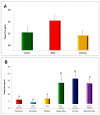Addressing Combative Behaviour in Spanish Bulls by Measuring Hormonal Indicators
- PMID: 38668449
- PMCID: PMC11053816
- DOI: 10.3390/vetsci11040182
Addressing Combative Behaviour in Spanish Bulls by Measuring Hormonal Indicators
Abstract
The fighting bull is characterised by its natural aggressiveness, but the physiological mechanisms that underlie its aggressive behaviour are poorly studied. This study determines the hormonal component of aggressiveness in fighting bulls by analysing their behaviour during a fight and correlating it to their serotonin, dopamine and testosterone levels. We also determine whether aggressive behaviour can be estimated in calves. Using 195 animals, samples were obtained when the animals were calves and after 5 years. Aggressiveness scores were obtained by an observational method during bullfights, and serotonin, dopamine and testosterone levels were determined in all animals using validated enzyme immunoassay kits. The results revealed a strong correlation of serotonin and dopamine levels with aggressiveness scores in bulls during fights, but no correlation was found with respect to testosterone. These correlations led to established cut-off point and linear regression curves to obtain expected aggressiveness scores for calves at shoeing. There were no significant differences between the expected scores obtained in calves and the observed scores in bulls. Therefore, this study demonstrates that hormone determination in calves may be a great indicator of combativeness in bulls and can reliably be used in the selection of fighting bulls.
Keywords: dopamine; fighting bull; serotonin; testosterone.
Conflict of interest statement
The authors declare no conflicts of interest.
Figures











References
-
- Silva B., Gonzalo A., Cañón J. Genetic parameters of aggressiveness, ferocity and mobility in the fighting bull breed. Anim. Res. 2006;55:65–70. doi: 10.1051/animres:2005046. - DOI
-
- Menéndez-Buxadera A., Cortés O., Cañon J. Genetic (co)variance and plasticity of behavioural traits in Lidia bovine breed. Ital. J. Anim. Sci. 2017;16:208–216. doi: 10.1080/1828051X.2017.1279035. - DOI
LinkOut - more resources
Full Text Sources

